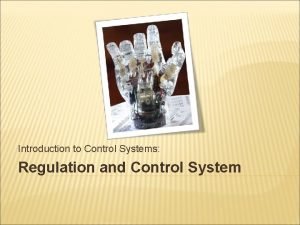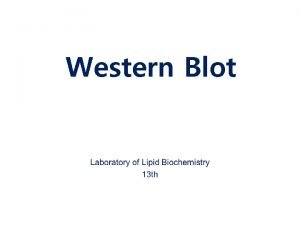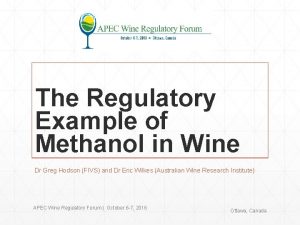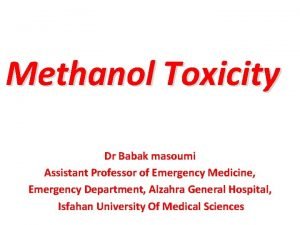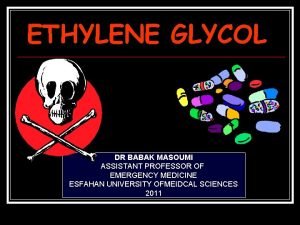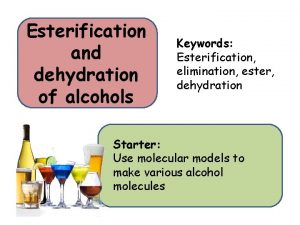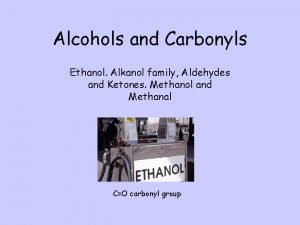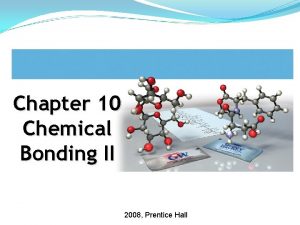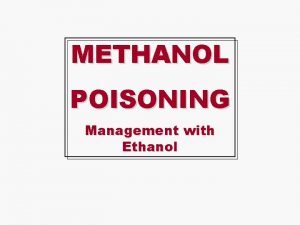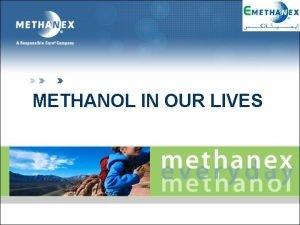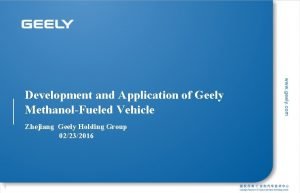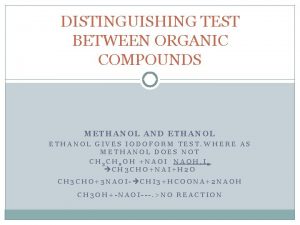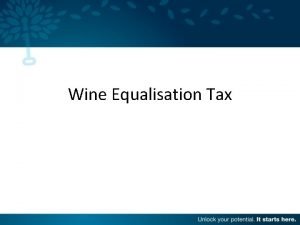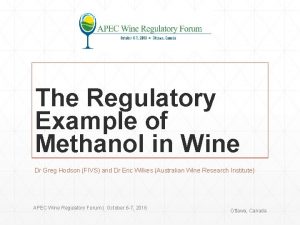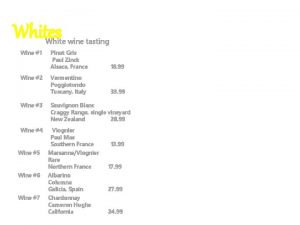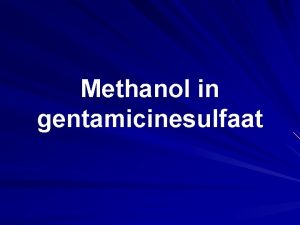The Regulatory Example of Methanol in Wine Dr




















- Slides: 20

The Regulatory Example of Methanol in Wine Dr Greg Hodson (FIVS) and Dr Eric Wilkes (Australian Wine Research Institute) APEC Wine Regulatory Forum | October 6 -7, 2016 Ottawa, Canada

Agenda ▪ What is Methanol? ▪ The Origin of Methanol in Wine ▪ Typical Levels of Methanol in Fruit Juices ▪ Toxicology of Methanol ▪ Regulatory Limits for Methanol in Wine ▪ Purpose for Methanol Limits in Wine ▪ Conclusions APEC Wine Regulatory Forum | October 6 -7, 2016 Ottawa, Canada 2

What is Methanol? ▪ Chemical formula: CH 30 H ▪ Synonyms: Methyl alcohol, Carbinol, Wood alcohol ▪ CAS Registry Number: 67 -56 -1 ▪ Physical appearance: Colourless liquid, characteristic odour ▪ Melting Point: -98°C ▪ Boiling Point: 65°C ▪ Solubility in water: miscible APEC Wine Regulatory Forum | October 6 -7, 2016 Ottawa, Canada 3

The Origin of Methanol in Wine 1 ▪ Produced before and during alcoholic fermentation from the hydrolysis of pectins by pectinase enzymes (such as methyl pectinesterase) which are naturally present in the fruit. ▪ More methanol is produced when must is fermented on grape skins; hence there is generally more in red wines than in rosé or white wines. APEC Wine Regulatory Forum | October 6 -7, 2016 Ottawa, Canada 4

The Origin of Methanol in Wine 2 ▪ Exogenous pectinase enzymes are permitted for use in winemaking (generally as clarifying agents) in many economies. As with the activity of pectinases naturally present in grapes, their use will tend to increase levels of methanol in the resulting wine. ▪ Use of DMDC (dimethyl dicarbonate, a permitted winemaking additive in many wine producing economies) will impart additional low levels of methanol to wine. As it breaks down in the product, it releases about 50% of its own concentration in methanol. Thus a maximum addition of 200 mg/L DMDC produces about an extra 100 mg/L methanol in the treated wine. APEC Wine Regulatory Forum | October 6 -7, 2016 Ottawa, Canada 5

Typical Levels of Methanol in Wine ▪ Red wines will tend to contain more methanol (between 120 and 250 mg/L of the total wine volume) than white wines (between 40 and 120 mg/L of the total wine volume), because of the longer exposure to grape skins during the fermentation. (W. R. Sponholz, “Der Wien 4. 3. Fehlerhafte und unerwünschte Erscheinungen im Wein, ” in Chemie des Weines, eds. G. Würdig and R. Woller (Stuttgart: Ulmer, 1989), 385 -411). ▪ Wines made from grapes that have been exposed to botrytis cinerea (e. g. late harvest wines, Sauternes) also have higher methanol levels than standard grape wines (as much as 364 mg/L of the total wine volume). (Wine Analysis and Production, eds B Zoecklein et al. (1995), published by Chapman & Hall, page 107). ▪ Wines made from non vitis vinifera grapes tend to contain more methanol than wine from pure vitis vinifera (Handbook of Enology Volume 2: The Chemistry of Wine Stabilization and Treatments 2 nd Edition, eds P Ribereau. Gayon et al. (2006), published by John Wiley & sons, page 53). APEC Wine Regulatory Forum | October 6 -7, 2016 Ottawa, Canada 6

Typical Levels of Methanol in Fruit Juices ▪ Non-alcoholic fruit juices naturally contain an average of 140 mg/L of methanol, in a range from 12 mg/L to as much as 640 mg/L. Chih-Yao Hou, Yeong-Shenn Lin, Yuh Tai Wang, Chii-Ming Jiang and Ming-Chang Wu, “Effect of storage conditions on methanol content of fruit and vegetable juices, ” Journal of Food Composition and Analysis, Volume 21, Issue 5, (August 2008), 410– 415. NPCS Board of Consultants & Engineers, The Complete Technology Book on Alcoholic and Non-alcoholic Beverages (Fruit Juices, Whisky, Beer, Rum and Wine, (Delhi: Asia Pacific Business Press Inc. , 2008), 712. J. J. Clary, The Toxicology of Methanol (Chichester: John Wiley & Sons Ltd, 2016), 48. ▪ The average level of methanol in fruit juice is thus quite similar to the average methanol level in white wine and within the range of values seen for red wines. APEC Wine Regulatory Forum | October 6 -7, 2016 Ottawa, Canada 7

Case Study Typical levels of methanol in Australian wine ▪ A recent survey looked at 150 wines from across Australia to determine typical levels of Methanol in commercial wine. ▪ The sample set consisted of 90 reds and 60 white from multiple varieties and vintages. ▪ All wines were analysed using an using GC-FID in the Australia Wine Research Institutes ISO 17025 accredited laboratory. ▪ No evidence of DMDC (a source of methanol) treatment for any of the wines tested. APEC Wine Regulatory Forum | October 6 -7, 2016 Ottawa, Canada 8

Typical Values ▪ Results for reds and white wine were significantly different. ▪ Reds were typically higher in concentration and reflected a broader distribution reflecting greater variation in skin contact. ▪ All wines were found to be within Australian and OIV guidelines APEC Wine Regulatory Forum | October 6 -7, 2016 Ottawa, Canada 9

Impact of Variety ▪ No significant differences based on variety. ▪ Only difference was based on red v’s white reflecting the differences in processing for the different wine styles APEC Wine Regulatory Forum | October 6 -7, 2016 Ottawa, Canada 10

Impact of vintage ▪ No significant impact of year of production on the methanol concentration. APEC Wine Regulatory Forum | October 6 -7, 2016 Ottawa, Canada 11

In summary ▪ Typical ranges for methanol in Australian wines found were; ▪ 60 -280 mg/L in reds (mean 170 mg/L) ▪ 40 -120 mg/L in whites (mean 58 mg/L) ▪ All wines tested had some methanol content. ▪ The main driver for higher methanol levels appeared to be skin contact during processing. ▪ Variety or vintage had no significant impact. APEC Wine Regulatory Forum | October 6 -7, 2016 Ottawa, Canada 12

Toxicology of Methanol ▪ The Food and Drug Administration of the United States of America (FDA), 1993 ▪ United Nations World Health Organization International Programme on Chemical Safety, 1997 ▪ European Commission Scientific Committee on Food, 2001 APEC Wine Regulatory Forum | October 6 -7, 2016 Ottawa, Canada 13

Toxicology of Methanol: The Food and Drug Administration of the United States of America (FDA), 1993 ▪ The No Observed Adverse Effect Level (NOAEL) in humans for methanol is 71 to 84 mg/kg body weight (bw)/day. Because this NOAEL was derived from studies in humans, the FDA developed an Acceptable Daily Intake (ADI) of 7. 1 to 8. 4 mg/kg bw/day by using a safety factor of 10. Federal Register 58, No. 204, (January 26 1993), 6088– 6091. ▪ An individual weighing 70 kg would have to consume about 1. 25 litres of wine (almost 2 bottles) a day with a methanol content of 400 mg/L (the methanol limit for red wines recommended by OIV and several economies) to reach the low end of this ADI range. APEC Wine Regulatory Forum | October 6 -7, 2016 Ottawa, Canada 14

Toxicology of Methanol: United Nations World Health Organization International Programme on Chemical Safety, 1997 ▪ It is difficult to do a risk assessment on methanol because the chemical itself and its primary metabolites of concern are naturally present in humans – a fact that pre-supposes a certain level of these substances poses no toxic risk. (United Nations World Health Organization International Programme on Chemical Safety, http: //www. inchem. org/documents/ehc/ehc 196. htm) ▪ A level of methanol intake is proposed that is of insignificant risk to humans, in that it causes no increase in the most toxic metabolite (formic acid) above normal background levels found in humans. That intake level is a single oral exposure of 20 mg/kg body weight, or 1400 mg for an individual weighing 70 kg. ▪ To ingest this amount of methanol from a wine containing 400 mg/L methanol (the methanol limit for red wines recommended by OIV and several economies), that individual would need to consume 3. 5 litres of wine in a single oral exposure. APEC Wine Regulatory Forum | October 6 -7, 2016 Ottawa, Canada 15

Toxicology of Methanol: European Commission Scientific Committee on Food, 2001 ▪ A healthy individual can metabolize 1500 mg per hour of methanol without showing any ill effects. European Commission Scientific Committee on Food. Opinion of the Scientific Committee on Food on the use of dimethyl dicarbonate (DMDC) in wines, (2001). ▪ Note that 1500 mg of methanol is approximately the amount of methanol contained in 3. 75 litres of a wine with a methanol content of 400 mg/L (the methanol limit for red wines recommended by OIV and several economies). ▪ This volume of wine would have to be consumed in one hour to ingest more methanol than a healthy individual could metabolise with no ill effects. APEC Wine Regulatory Forum | October 6 -7, 2016 Ottawa, Canada 16

Regulatory Limits for Methanol in Wine Methanol limits based on volume of wine Argentina, Chile, China, India, Vietnam, OIV Canadian Provinces (Ontario, Quebec) Japan, Korea, USA Republic of Georgia South Africa Switzerland 400 mg/L of wine (Red) 250 mg/L of wine (White and Rosé) 400 mg/L of wine 0. 1% (or about 1000 mg/L) of wine 0. 05 mg/kg 300 mg/L of wine 300 mg/L of wine (Red) 150 mg/L of wine (White and Rosé) 420 mg/dm 3 10 mg/kg (about 10 mg/L) of wine Thailand Turkey Methanol limits based on alcohol content of wine Australia, Mexico, New Zealand, Singapore, Chinese Taipei Indonesia APEC Wine Regulatory Forum | October 6 -7, 2016 3 g/L of ethanol 2 g/L of ethanol 0. 1% based on ethanol Ottawa, Canada 17

Purpose for Methanol Limits in Wine ▪ Comparing maximum permitted levels of methanol in wine with the levels known to be safe for human consumption, it is clear that the methanol limits currently in place do not serve a public health purpose. ▪ It is possible that at one time, the limit provided an indicator of appropriate fruit handling during harvest and processing – hence separate limits for red wines vs white and rosé wines. ▪ This index is rendered less meaningful today since there are other potential sources of methanol in winemaking APEC Wine Regulatory Forum | October 6 -7, 2016 Ottawa, Canada 18

Conclusions ▪ Methanol limits are set by economies for technological, not toxicological reasons, comparing the limits that have been established with available toxicity information. ▪ The current limits serve no public health purpose, and may not therefore be risk-based. Therefore, it may be possible to abandon them. ▪ The numerical values of the limits vary between economies for no obvious reason, and the units in which even numerically identical limits are expressed can vary, making them appear to be different and increasing the opportunity for error. ▪ Therefore, if economies decide to retain methanol limits for wine, there is scope for trade facilitation through harmonization of both the limits and their units of expression. APEC Wine Regulatory Forum | October 6 -7, 2016 Ottawa, Canada 19

Questions? APEC Wine Regulatory Forum | October 6 -7, 2016 Ottawa, Canada
 Regulatory control system with example
Regulatory control system with example Running buffer 역할
Running buffer 역할 Examples of methanol
Examples of methanol Lewisstructuur methanol
Lewisstructuur methanol Methanol poisoning
Methanol poisoning Methanol vs ethylene glycol
Methanol vs ethylene glycol Propanol and propanoic acid ester
Propanol and propanoic acid ester Methanol to propylene
Methanol to propylene Ethanol use
Ethanol use Methanol combustion equation
Methanol combustion equation Methanol geometric structure
Methanol geometric structure Methanol mechanism of action
Methanol mechanism of action Alkaanzuur formule
Alkaanzuur formule Methanol uses
Methanol uses Geely
Geely Test for benzoic acid
Test for benzoic acid Wet payable
Wet payable Hát kết hợp bộ gõ cơ thể
Hát kết hợp bộ gõ cơ thể Ng-html
Ng-html Bổ thể
Bổ thể Tỉ lệ cơ thể trẻ em
Tỉ lệ cơ thể trẻ em
